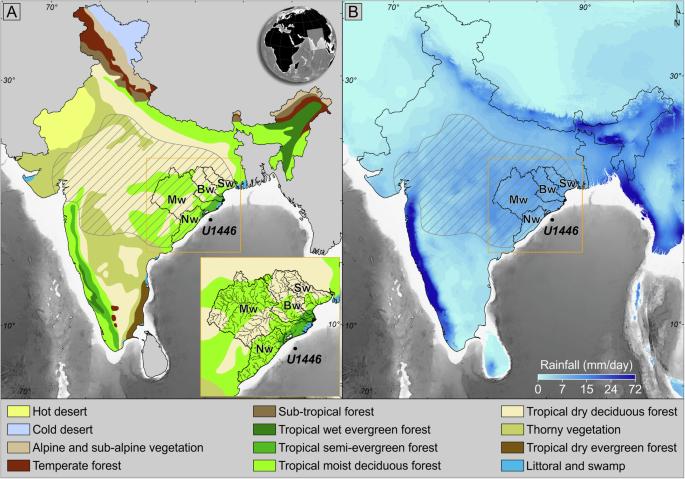Greening of India and revival of the South Asian summer monsoon in a warmer world
IF 8.1
1区 地球科学
Q1 ENVIRONMENTAL SCIENCES
引用次数: 0
Abstract
While it is accepted that the tropical hydrological cycle has intensified during past interglacial periods due to changes in insolation, greenhouse gases and ice volume, their respective influences are uncertain. Here we present a pollen record from Bengal Bay to reconstruct vegetation changes in India’s core monsoon zone during two warm periods, the current and last interglacial, comparing the data with numerical model simulations to assess the influence of different forcing mechanisms. Results show tropical forest expansion between 11.7-5 ka and 127-120 ka, defining two Indian humid periods, with the last interglacial showing the strongest monsoon activity, consistent with salinity reconstructions. Model-data comparison highlights boreal summer insolation as the primary driver of vegetation dynamics and monsoon intensity during interglacial periods, with CO2 and ice-sheets having a limited effect. Vegetation remains unaffected by pre-industrial CO2 variations above 250 ppmv, a threshold value that characterizes most interglacials of the last million years. Tropical forest markedly expanded between 11.7 and 5 ka and especially between 127 and 120 ka, due to greater monsoon activity mainly driven by insolation forcing, according to analysis of a Bay of Bengal pollen record and model results.

在气候变暖的世界中绿化印度和恢复南亚夏季季风
在过去的间冰期,热带水文循环因日照、温室气体和冰量的变化而加剧,这一点已得到公认,但它们各自的影响还不确定。在此,我们展示了来自孟加拉湾的花粉记录,以重建印度核心季风区在当前和上一个间冰期两个温暖时期的植被变化,并将数据与数值模型模拟结果进行比较,以评估不同强迫机制的影响。结果表明,在 11.7-5 ka ka 和 127-120 ka ka 之间,热带雨林扩张,定义了两个印度湿润时期,上一个间冰期季风活动最强,与盐度重建结果一致。模型与数据对比显示,北方夏季日照是间冰期植被动态和季风强度的主要驱动力,二氧化碳和冰盖的影响有限。工业化前的二氧化碳变化超过 250 ppmv(这是过去一百万年间大多数间冰期的临界值)时,植被仍然不受影响。根据对孟加拉湾花粉记录和模型结果的分析,在 11.7 ka 到 5 ka 之间,特别是 127 ka 到 120 ka 之间,热带森林明显扩大,这主要是由日照强迫驱动的季风活动增加所致。
本文章由计算机程序翻译,如有差异,请以英文原文为准。
求助全文
约1分钟内获得全文
求助全文
来源期刊

Communications Earth & Environment
Earth and Planetary Sciences-General Earth and Planetary Sciences
CiteScore
8.60
自引率
2.50%
发文量
269
审稿时长
26 weeks
期刊介绍:
Communications Earth & Environment is an open access journal from Nature Portfolio publishing high-quality research, reviews and commentary in all areas of the Earth, environmental and planetary sciences. Research papers published by the journal represent significant advances that bring new insight to a specialized area in Earth science, planetary science or environmental science.
Communications Earth & Environment has a 2-year impact factor of 7.9 (2022 Journal Citation Reports®). Articles published in the journal in 2022 were downloaded 1,412,858 times. Median time from submission to the first editorial decision is 8 days.
 求助内容:
求助内容: 应助结果提醒方式:
应助结果提醒方式:


